Peddling unproven treatments, stem cell industry ‘fleeces,’ sometimes harms patients
Elizabeth Noble flew from Kansas City to Florida in 2015 looking for a miracle cure for the macular degeneration that was slowly robbing her of sight.
Instead, she became an early cautionary tale about the dangers of a largely unregulated stem cell industry that has since expanded all over the United States, including Kansas City.
Noble, a retired University of Missouri-Kansas City professor, was 72 when she traveled to the U.S. Stem Cell Clinic in Sunrise, Florida.
According to court records and medical case studies, she had 20/60 vision in her right eye and 20/30 in her left when she entered the clinic: worse than normal, but certainly not debilitating.
She paid $5,000 for clinic staff to withdraw fat from her abdomen, extract stem cells from it and then inject a mixture of the cells and her blood plasma into both eyes.
Three days later Noble showed up at the University of Miami’s Bascom Palmer Eye Institute, with severe pressure and bleeding in her eyes. Doctors there did what they could to help, but her retinas were badly damaged. In the months that followed, both retinas would atrophy, and one would detach, leaving her unable to see any light in either eye. She was legally and functionally blind, suffering “bodily injury, pain and suffering, disability (and) disfigurement,” according to a lawsuit she filed.
Years later, after several more complaints, the Food and Drug Administration took U.S. Stem Cell to court and forced the company to stop its eye injections. But by then the for-profit stem cell industry had spread like a virus, despite warnings from medical researchers and bioethics experts that the clinics are peddling unproven, sometimes dangerous treatments for anything from mild arthritis to erectile dysfunction to multiple sclerosis and Parkinson’s disease.
“The companies are making a killing off of all of us that have creaky knees and bad elbows and throwing injuries,” said Christopher Scott, a medical ethics expert at the Baylor College of Medicine who has studied the for-profit stem cell industry. “They are basically fleecing people for thousands of dollars for these interventions that simply don’t work. And they do it because they can.”
By some estimates, 1,000 clinics in the United States now offer stem cell treatments that haven’t been vetted and approved by the FDA — including at least five in the Kansas City area.
While representatives of area clinics are quick to say they’re not injecting eyeballs, they’re doing just about everything else. They’re extracting cells from patients’ fat and bone marrow or getting them from tissue banks that traffic in donated umbilical cord blood or amniotic fluid and then injecting them into knees, shoulders and backs or infusing them intravenously.
All of the clinics take pains to reassure potential customers that they aren’t using controversial embryonic stem cells.
None of the clinics in the Kansas City area has been publicly linked to any injuries. But The Star found that several use or have used a tissue supplier whose products caused at least a dozen serious infections in other states. And at informational seminars hosted across the metro, clinic representatives routinely overstate the evidence for their treatments for all sorts of maladies and downplay the risks.
Clinic owners said they’re offering a valuable alternative to surgery and opioids. They say they have helped hundreds of people and have the patient testimonials to prove it.
But researchers say that without controlled studies that compare those treatments to placebos, the testimonials are almost meaningless scientifically.
“At a core, medicine-science level, this stuff is not proven,” said Paul Knoepfler, a researcher from the University of California, Davis who tracks the unregulated stem cell industry. “My view is that it shouldn’t be sold until they’re proven.”
Experts like Knoepfler and Scott say that at best the clinics are charging people thousands for treatments that may be no more effective than saltwater. At worst, they’re harming people. In addition to Noble, others who say they’ve been injured by stem cell treatments include:
▪ Two other women who say they were also blinded by U.S. Stem Cell, and a third who says she felt faint and started vomiting right after getting arthritis injections there.
▪ Several patients who say they suffered similar damage after getting eye injections at other clinics in Florida and Georgia.
▪ At least 17 people across five states hospitalized with serious infections caused by umbilical cord products contaminated with various organisms including E. coli, a bacterium found in feces.
Sunil Abhyankar, the director of the Midwest Stem Cell Therapy Center at the University of Kansas Medical Center, said unregulated clinics are threatening the credibility of the entire stem cell research field.
Stem cells show promise, Abhyankar said, and his institution is doing the slow, painstaking work of running clinical trials to figure out how to use them safely and effectively. But in the meantime, patients should be skeptical of clinics that charge them lots of money while promising miraculous effects for a wide range of conditions.
“There is a lot of research that needs to be done before we can claim that these cells are truly, you know, doing what we hope they can do,” Abhyankar said. “And this research has to be done within the context of the FDA framework for clinical trials.”
As clinics have sprouted up around Kansas City, Abhyankar said KU is getting more calls from people looking for advice about them. He put together a list of questions for patients to ask and posted it online at kumc.edu/msctc/adult-stem-cell-therapy-101.
Abhyankar also warned that although some stem cell clinics list their services on ClinicalTrials.gov, that does not mean they’re FDA-approved trials. Some of the procedures that allegedly caused eye injuries were among those listed on the government site, which has few restrictions on what is posted there. Critics say stem cell clinics “co-opt” the site “to market unproven therapies,” according to a June story in Stat, a health news website.
So far, the FDA hasn’t taken action against stem cell clinics in any comprehensive way, instead taking a few particularly bad actors to court while issuing an escalating series of warnings to the rest of the industry.
Agency leaders have promised more action is coming.
But Scott said they’ve let the industry grow too big, and now it will be difficult to rein it in.
“In my view,” Scott said, “the FDA has a bonfire on its hands.”

The victims
Noble’s Florida attorney, Andrew Yaffa, said because of a legal settlement she cannot talk about what happened to her beyond what’s in the public record.
But he said that since he started representing plaintiffs injured by U.S. Stem Cell, his phone has been ringing continually with people who say they have similar stories.
“I have represented five separate people and been contacted by dozens and dozens (more),” Yaffa said. “From across the United States. I’ve been contacted from Arizona, California, Atlanta, all over the state of Florida.”
Like Noble, Jeff Ariss wanted to try a stem cell treatment for macular degeneration, so he traveled from his home in Canada to a different Florida stem cell clinic.
Ariss said Canada has few such clinics.
“Because of our medical system, it’s government controlled,” Ariss said. “It’s tightly controlled and we don’t have that shit happening here, these bullshit clinics. The States are a little looser with their governing process, and the FDA sure takes their time to do anything about it.”
While the FDA eventually obtained an injunction to stop eyeball injections at U.S. Stem Cell, it has not taken legal action against the Florida clinic Ariss used.
That clinic was run by doctors Steven Levy and Jeffrey Weiss. It seemed reputable, and the eye treatment was listed on ClinicalTrials.gov, so Ariss thought it was legit. But the results were much the same as Noble’s.
When he woke up, all sorts of “floaters” obscured his vision, and it never got better, he said. One of his retinas detached, and he ended up legally blind.
“I was desperate,” Ariss said. “I’ve been going blind for 19 years now and it sucks. I jumped the gun and I obviously shouldn’t have and this is where I ended up. He has no remorse whatsoever.”
Ariss said he paid the clinic $22,000 and then spent $40,000 to $50,000 at other medical centers trying in vain to fix the damage.
He said he considered suing but found out Weiss wasn’t carrying malpractice insurance. That’s allowed in Florida and about 30 other states, including Missouri. Such doctors are liable for any injuries, but if they don’t have the money, plaintiffs have no guarantee of collecting on a settlement or judgment.
Weiss didn’t respond to a request for an interview. Levy offered only a brief response when reached by phone.
“We are a regulated study and frankly I have no comments,” Levy said. “We have not caused any patients to go blind.”
In a follow-up email, Levy and Weiss said they’ve treated about 600 people and the “overwhelming majority” are happy with the results. They said that the few patients complaining were already mostly blind and are just seeking money.
The pair have published a dozen papers about their stem cell injections, including some case studies citing significant vision improvements verified by doctors at the Johns Hopkins Wilmer Eye Institute and The Ohio State University.
One of those doctors, ophthalmologist Susan Benes, is no longer with Ohio State, a receptionist said. Benes didn’t respond to a message left at the Heart of the Rockies Regional Medical Center in Colorado, where she is now listed as a provider.
Optometrist Alexis Malkin was a part-time faculty member at Johns Hopkins when she co-authored a paper with Weiss and Levy. She is now a professor at New England College of Optometry. Reached via email, she said she didn’t participate in Weiss and Levy’s clinical trial but was one of the patient’s vision providers before and after the treatment. Malkin didn’t respond to follow-up requests for information about the patient’s results.
A research paper by four other eye doctors published in Retina Specialist magazine in February said at least 40 commercial stem cell companies offer eye treatments at 76 clinics across the country, despite little evidence they work.
“We found a paucity of publications supporting these treatments: no level 1, 2, 3 or 4 evidence,” the authors wrote, referencing a scale of evidence-based medicine developed by the University of Oxford.
While Levy and Weiss say they’re running a legitimate clinical trial, the magazine study’s authors wrote that patients should avoid any clinics that charge them to be research subjects, or inject both eyes at the same time.
“Legitimate scientific cell-therapy clinical trials are typically sponsored by either the government or companies and don’t ask for payment out-of-pocket,” they wrote. “Legitimate clinical trials don’t perform bilateral simultaneous treatments until safety has been demonstrated.”
Ariss said he’s since been in touch with several other patients whose vision quickly declined after they were treated by Weiss and Levy.
George Gibson, a 75-year-old from Pennsylvania, said that within an hour of leaving the clinic he was entirely blind in one eye. The other, fortunately, stayed the same.
In 2017, Gibson and his wife went back to the clinic with a BBC reporter to try to talk to Levy about what happened. Instead, the clinic staff called the police while they were sitting in the parking lot.
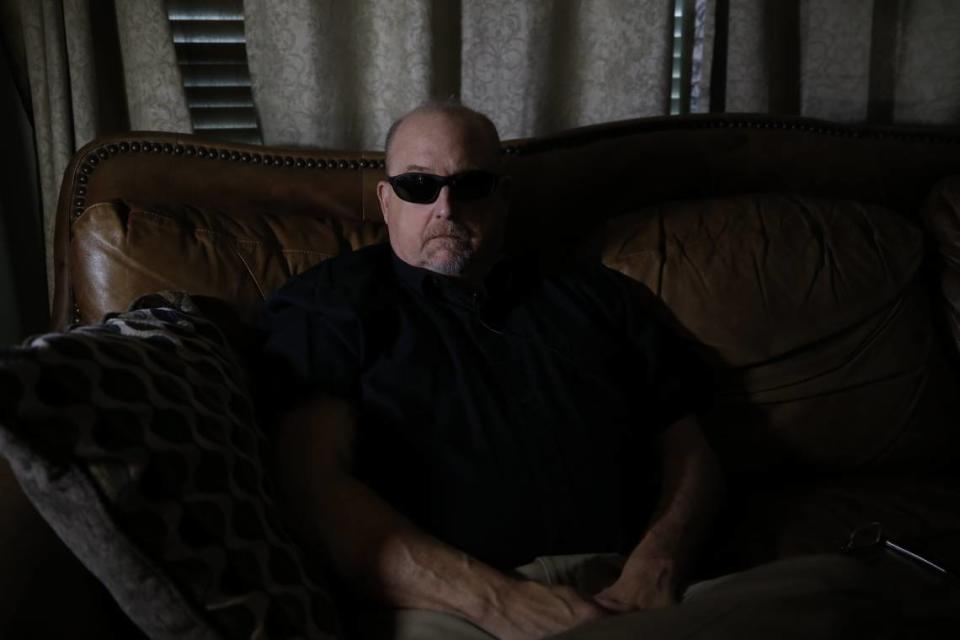
Tom Harris from Texas was only in his 50s when he got injections from Levy.
“Ended up being the worst decision I ever made in my life,” Harris said.
He said his vision was about 20/60 before the procedure, and he’s now completely blind in one eye and “severely impaired” in the other. He said his vision loss cost him an executive-level job with an aerospace engineering company that paid six figures. He’s now living off his savings.
“Once they got your money and once they’re done with your surgery, they don’t talk to you,” Harris said. “They don’t want to see you, they don’t want to hear from you. Nothing.”
Neither Gibson nor Harris sued Weiss and Levy. Gibson said he talked to an attorney who would not take the case because the doctors did not carry malpractice insurance.
About 100 miles down the road from Harris lives Timothy Lunceford, who was hospitalized for almost two months last year after getting a stem cell injection for back pain at a clinic in Texas.
“It felt like someone stuck a knife into the middle of my back and just left it there,” Lunceford, a 52-year-old wildlife biologist, told the Washington Post in February.
Lunceford filed a lawsuit, which ended in a settlement. It describes him developing a life-threatening infection, spending weeks wracked with pain and needing back surgery in which a neurosurgeon carefully excised infected tissue from around his spine.
Doctors found E. coli and one other type of bacteria in his back.
Lunceford’s was one of 12 hospitalizations that the Centers for Disease Control linked to products sold by Liveyon, a California-based distributor of stem cells from umbilical cord blood.
The victims, spread across Texas, Florida and Arizona, had injections in their knees, shoulders and backs at orthopedic centers and pain clinics. A few also had IV infusions.
Lunceford’s infection was probably the most serious, but other patients were hospitalized for 35, 30 and 15 days.
“It was awful,” said Harley Hampton, a Texas attorney who represented six of the victims. “These people had fevers in the 104, 105 (degree) range. They were delusional, hallucinating, had to be life-flighted to bigger facilities for a higher level of care. It’s a miracle that there aren’t some deaths.”
Liveyon officials have blamed the contamination on one of their suppliers, Genetech, and said they’re no longer buying umbilical cord tissue from that company.
But critics like Knoepfler have said that Liveyon’s sales pitch still seems more centered on making money than helping patients.
And several Kansas City-area companies have used or are still using Liveyon products.
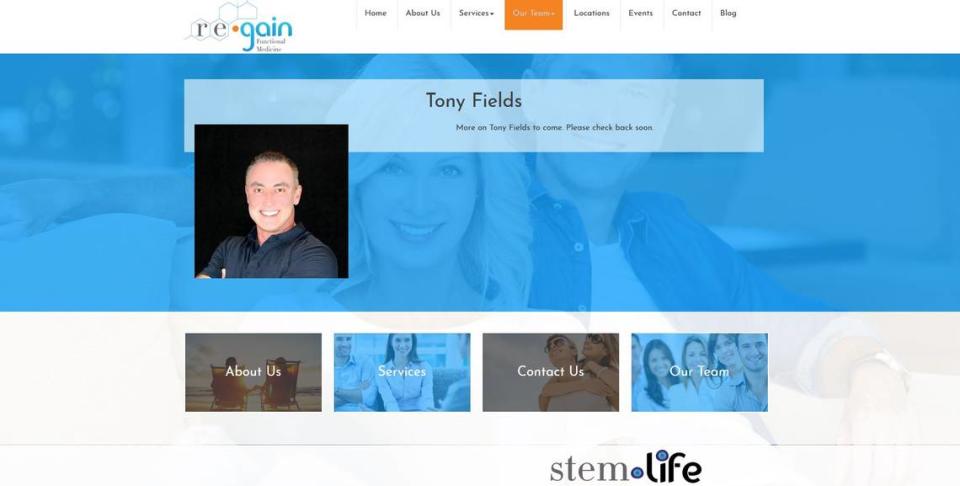
The seminars
In April, a small group of mostly elderly people gathered at a community center in Overland Park for a free seminar hosted by Tony Fields, managing partner of a Stem Cell Centers affiliate in Leawood called Stem Life.
Seminars like it are being held nearly every week in hotel conference rooms and community centers across the Kansas City metro. Clinic reps give a talk, and then audience members can sign up for a free consultation afterward. Sometimes they get a discount on their stem cell injections for attending.
A Star reporter who went to several seminars in the spring found that the presenters generally overstated the benefits of stem cells, downplayed the risks and occasionally made baseless statements.
Clinic spokespeople touted success rates of 85-95%, without explaining that those results weren’t based on a scientific study with a control group receiving a placebo.
They also said that there were virtually no risks, despite the documented injuries caused by clinics in other states.
Fields, who has no medical background, told the audience there are “no guarantees in medicine.” Yet he went on to say 80% of patients experience at least 80% improvement in their joint pain, 17% experience some lesser improvement and only 3% had none.
He also claimed the procedure is perfectly safe.
“People always ask me what’s the risk, what’s the side effects of it?” Fields said of stem cells. “They have a prolific presence in your body, especially when you’re young. They’re a healthy thing to do. They don’t hurt people. They actually help people.”
Fields’ company injects patients with other people’s stem cells, derived from umbilical cord blood purchased from tissue banks. Fields said none of the clinic’s patients had ever had a bad reaction, which he attributed to the stellar safety record of its supplier.
When The Star asked after the presentation who that supplier is, Fields said Liveyon.
Reached by phone later, Fields said Liveyon reps had told him that the contamination that caused infections at other clinics occurred after they shipped their products — which would directly conflict with the findings of the FDA and CDC.
“Stem cells themselves have no negative side effects, but if you don’t have sterile procedures in your clinic you can have an infection,” Fields said.
His clinic isn’t the only one using Liveyon locally.
The website for the aNu Aesthetics and Optimal Wellness spa near Kansas City International Airport advertised stem cell therapy using Liveyon’s ReGen Series — the exact product line that was recalled last year.
“At aNu, Dr. (Cristyn) Watkins and her team only use FDA approved umbilical cord-derived mesenchymal stem cells from Liveyon, which provides the industry’s highest-quality, independently screened and tested stem cells from an FDA-compliant lab,” read a page on the website.
The page was taken down after The Star left messages for Watkins seeking comment.
Watkins did not respond to those messages.
According to the Kansas medical licensing board, Watkins got her medical education at St. George’s University School of Medicine, a Caribbean institution referred to in a 2014 New York Times article as a “Second Chance Med School” for U.S. students who couldn’t get accepted to one stateside.
Matt Gianforte, a chiropractor whose clinic in Shawnee is part of the LifeWorks stem cell company network, said his company used Liveyon “only for a short period about three years ago for a limited number of patients” and now uses another supplier.
During a presentation in Lenexa a day after Fields’, Gianforte suggested to the audience of about 20 mostly senior citizens that the stem cells themselves could ward off infection — an assertion not supported by medical research.
“There’s always that risk for infection, though I’ve never seen any infection because these cells regulate the immune system,” Gianforte said during the presentation. “So if there was that infection that was maybe there they sort of take care of themselves, from our experience.”
Gianforte later said via email that he was speaking specifically about stem cell injections spurring the immune system to fight infections that were already there before the injection. He said he got that information — and most of what’s in his presentation — from “Stem Cell Therapy: A Rising Tide,” a book by a physician assistant named Neil Riordan who runs a stem cell clinic in Panama.
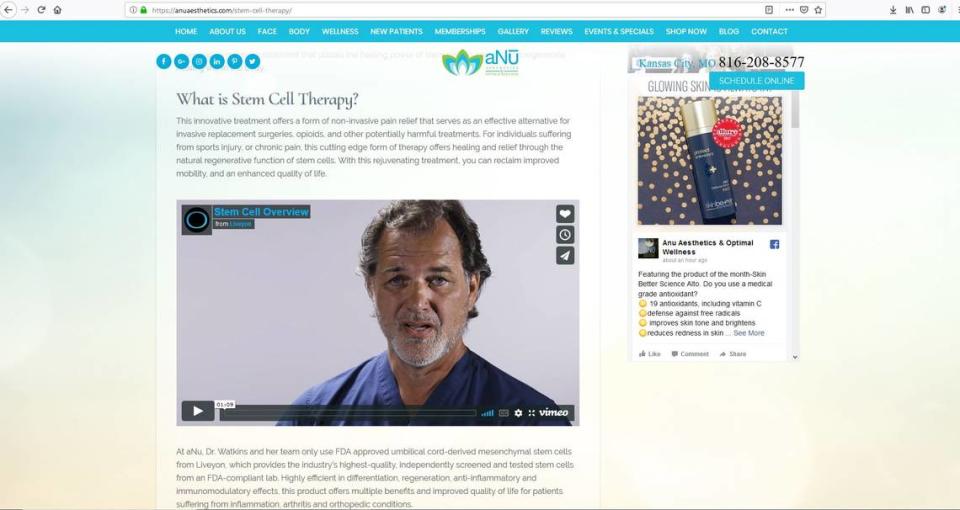
The conspiracy theory
A half-dozen people sat in folding chairs in a small conference room inside an Overland Park imaging center, waiting for another presentation on stem cells one evening this spring.
Ads for the seminar hosted by the Kansas Regenerative Medicine Center targeted people with arthritis in their knees and shoulders, as well as more debilitating conditions like multiple sclerosis and Parkinson’s disease.
“I guess everyone here has a pain somewhere,” an older man in the front row said, turning in his chair to scan the room.
“Mine’s a big pain,” a middle-aged man in a wheelchair replied. “I can’t get my legs to work.”
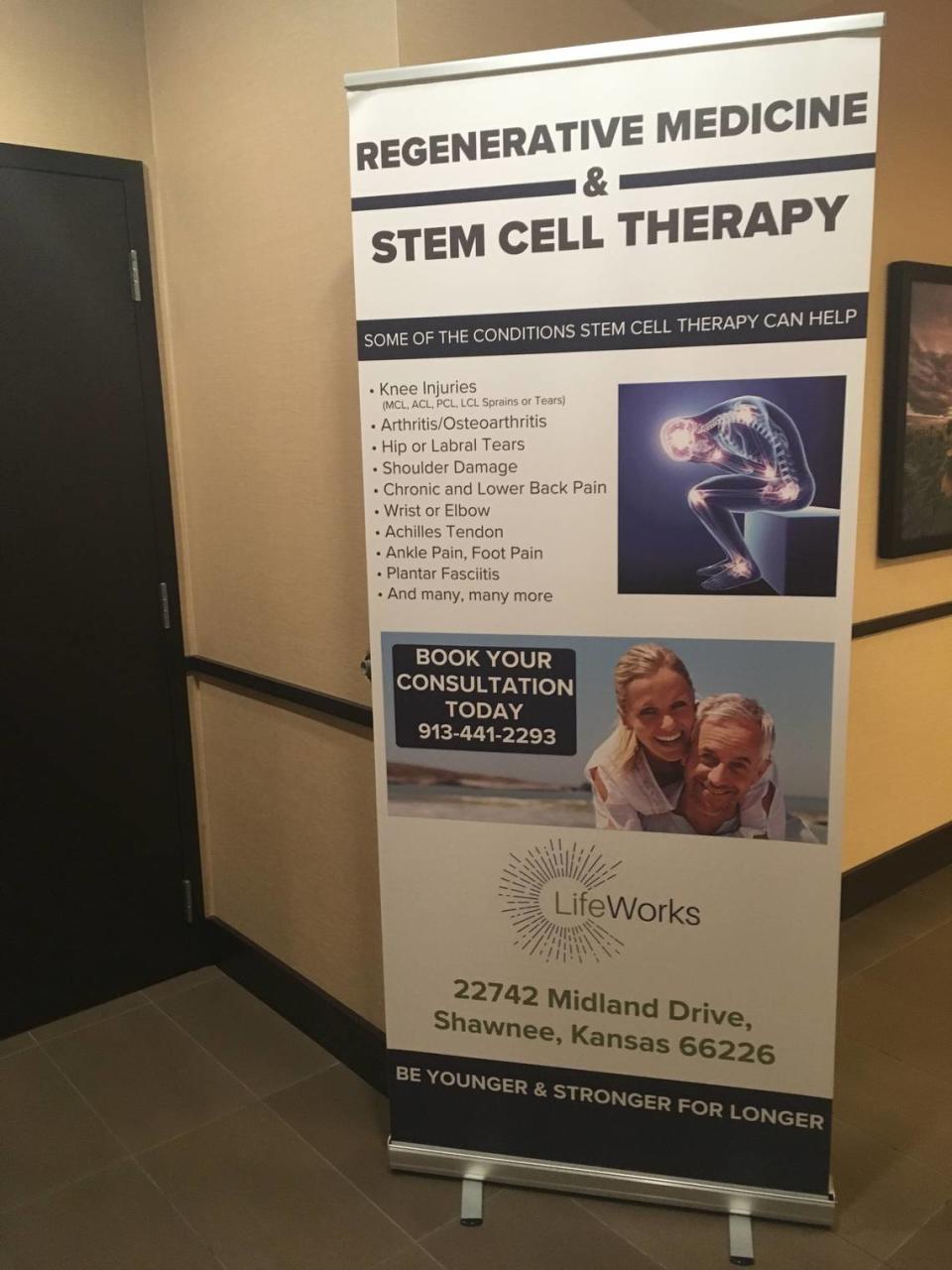
Over the next hour they watched a video that featured a celebrity endorsement from former Kansas State University football coach Bill Snyder and then had an in-person Q&A session with Ekwensi Griffith, a doctor who used to play for Snyder.
The man in the wheelchair asked Griffith why Kansas Regenerative Medicine’s stem cell treatments — which run about $9,000 apiece — aren’t approved by the FDA or covered by insurance.
Griffith blamed a conspiracy between insurers and the pharmaceutical industry.
“Let’s suppose an insurance company says, I want to try stem cells on my patients cause I think it might save my patients from having to have surgeries, (because) ultimately insurance companies care about the bottom line, right?” Griffith said. “So here’s what Pfizer turns and says: You want 20% off your chemo? Pardon me? Yeah, you want 20% off your chemo drugs? They (insurance companies) sit there and do a bottom line (analysis). You make it 25% off chemo drugs, we’ve got a deal. Stem cells get thrown where? Back on the back line.”
Knoepfler, the UC Davis researcher, said that’s a common but baseless accusation.
“I’ve heard that conspiracy theory many times before too, and I ask, ‘What’s the evidence for that?’ and they don’t really have any evidence,” Knoepfler said. “But the FDA and Big Pharma make easy targets to use as punching bags.”
Reached by phone later, Griffith said he meant Pfizer to be a stand-in for the pharmaceutical industry as a whole. But he also said he doesn’t actually believe pharmaceutical companies and insurers are “in direct collusion” to keep stem cell treatments off the market.
“I mischaracterized that and I apologize for that,” Griffith said. “I did a very poor job of characterizing why they’re not approved.”
He said that insurance companies have actually told him they don’t cover the treatments because they aren’t proven, but he disagrees.
A few months after giving his presentation in Overland Park, Griffith opened his own clinic in Lenexa advertising stem cell injections for, among other things, erectile dysfunction.
KC area’s first clinic
Kansas Regenerative Medicine, founded in Manhattan about five years ago, was the first stem cell clinic anywhere near Kansas City.
Its founder, Kansas rancher John Farley, said he decided years ago he didn’t want more surgeries for his joint injuries, so he started looking for alternative treatments.
His brother worked with a veterinarian in California who knew a doctor in Beverly Hills who was taking fat out of people, spinning out the stem cells in a centrifuge and then injecting them back into joints. Farley said he flew out there, had the procedure and within weeks was feeling much better.
“That made me a believer in stem cell therapy,” Farley said.
When he came back from California, Farley started the Kansas Regenerative Medicine Center with help from a few friends, including a veterinarian, Corey Orava, who had studied the use of stem cell treatments in animals and still serves as a scientific adviser for the clinic.
They’ve since expanded, adding a clinic in Overland Park. They have five doctors under contract, and Farley says they’ve treated almost 2,000 patients.
But they’re not certified to manipulate stem cells — at least according to the Foundation for the Accreditation of Cellular Therapy, a national oversight group run by the University of Nebraska Medical Center.
The foundation runs a voluntary inspection and evaluation program to verify that centers are meeting certain standards for the collection, processing and administration of human cells.
The only organizations the foundation recognizes in the Kansas City area are KU Med and Children’s Mercy Hospital’s blood and bone marrow transplant center.
Abhyankar said his stem cell center at KU Med, largely funded through state tax dollars, is doing an FDA-approved clinical trial using a type of umbilical cord stem cell to treat graft-versus-host disease.
The patients are carefully selected, closely tracked and don’t pay anything for the treatment.
“We’re following a path that centers should take before they make claims,” Abhyankar said.
Farley and Orava said they tried applying for National Institutes of Health grants to follow that same path but didn’t get them.
“It’s so costly to do those clinical trials, and the big universities get all the money,” Farley said.
The Beverly Hills doctor who inspired Farley to start Kansas Regenerative Medicine, Mark Berman, has since been sued by the FDA. Federal agents raided his lab in 2017 and seized five vials of live smallpox vaccine — a restricted substance — that Berman was combining with stem cells and injecting into cancer patients.
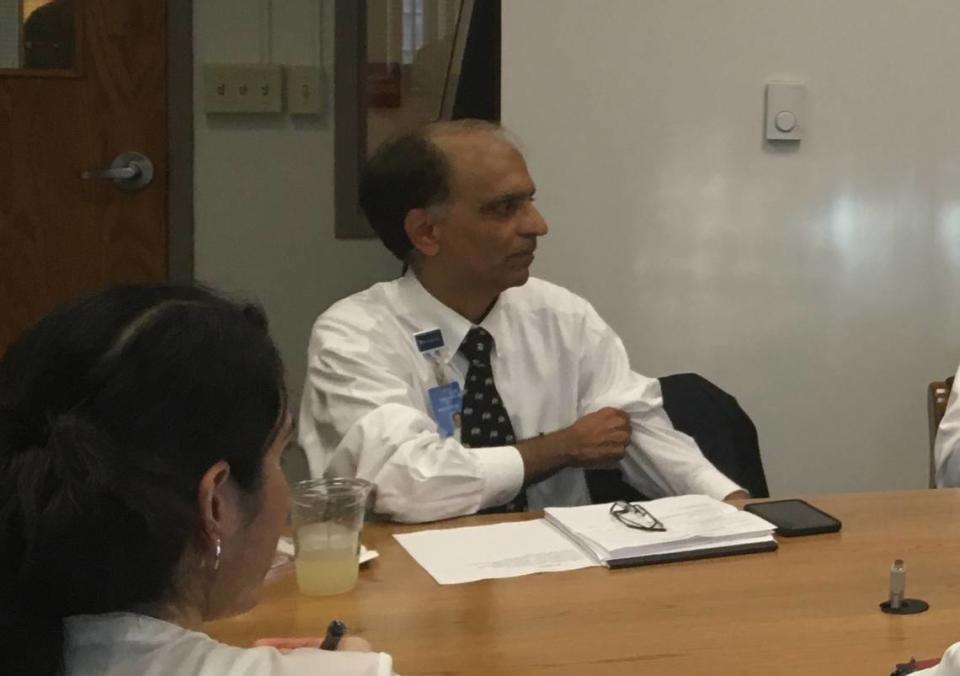
The placebo effect
Stem cells are the raw material of human tissue, able to develop into many other cell types. They’re derived from bone marrow and umbilical cord or amniotic tissue and have been approved for treating a small set of illnesses: certain types of cancers and blood disorders.
Most stem cell clinics are using them “off-label,” meaning for uses other than what they were tested for.
Experts say there’s not enough evidence that those cells, or the fat cells other clinics are using, can effectively treat the myriad illnesses they’re now being marketed for.
Some studies show promise for treating arthritis with adult stem cells, but most of the trials have been extremely small, many have no placebo group and few had any long-term follow-up to see if the self-reported benefits of treatment last.
The University of Missouri Health Care’s BioJoint Center in Columbia uses stem cells from bone marrow for only one purpose: to promote healing when donor bone is grafted onto a patient’s bone. But the center does not recommend using stem cells “for injections into joints, tendons, ligaments, meniscus, or muscle for any purpose.
“The current scientific studies do not provide sufficient evidence for the efficacy of stem cells for these purposes,” the center’s website says, “and there are some significant risks as well.”
The evidence that stem cells can treat other conditions is even more preliminary.
Take multiple sclerosis. The MS Society says that although stem cell research has “generated a great deal of interest and holds promise, the field is in its infancy and much more research is needed before cell based therapies become a MS treatment option.”
The Kansas Regenerative Medicine Center is taking money from people with MS now. But Farley said it doesn’t promise them too much.
“We’re very careful on auto-immune things to not tell them it’s going to cure; maybe help deal with their symptoms, maybe slow down the progress and know that this is probably going to have to be an ongoing thing,” Farley said. “But we’ve had some pretty good successes with MS, which is amazing. And they just kind of word-of-mouth come to us, and we just tell them, you know what, if you want to try this, that’s great. But you know we don’t know much about it, but it’s working to knock down the inflammation.”
During a joint interview at a coffee shop after Griffith’s seminar, Orava and Farley acknowledged that the Kansas Regenerative Medicine Center’s fat stem cell injections are not a clinical trial. And they’re not an FDA-approved treatment.
So, what are they?
“I would say it’s investigational,” Farley said.
Orava interrupted, noting that “investigational” is a technical term for drugs that are currently part of a controlled, FDA-compliant study.
“Well, yes and no,” Orava said. “Is it investigational? It’s not a clinical trial, per se. Some people would call it ‘patient-funded research’ because we are collecting data, the network that we’re a part of.”
Farley said that data is almost entirely positive.
But they’re not comparing it to a control group — a set of patients who think they might be getting stem cells but are instead getting injections of something like water or saline.
That’s the only way to determine whether the stem cell treatments are actually working or if the improvement patients report in their pain is due to the placebo effect.
A 2017 analysis of multiple studies showed that 80% of people reported improvement in their knee pain after getting injections of normal saline — nothing more than saltwater.
Orava said it’s not particularly important to suss out whether it’s the stem cells or the saline they’re sometimes in that are relieving pain, as long as patients are reporting relief. He said he sent his own wife to Farley’s clinic for joint pain and she had tremendous results.
“Could it have been saline?” Orava said. “Of course it could have been saline. The bottom line is, does she care?”
But Scott, the medical ethicist from Baylor, said that’s not how modern medicine works.
“Patient testimonials are a powerful way of selling snake oil,” he said. “You see it all the way back to the 1800s. That ain’t a clinical trial. That’s anecdote. Evidence-based medicine is what drives therapies everywhere in Western ways of doing medicine.”
Abhyankar also recoiled at the idea that it doesn’t matter whether a patient’s pain is being relieved by the treatment or the placebo effect.
“That is a huge red flag in my opinion,” Abhyankar said. “Because you are charging a lot of money to give them the placebo treatment and also, you know, some of these treatments have been dangerous.”
Farley said his treatments aren’t dangerous. His clinics are not using stem cells from tissue distributors like Liveyon and they’re not injecting eyeballs.
He said he met personally with FDA officials to try to figure out how to appease them, but they believe his treatments should be regulated like a drug and he doesn’t agree.
“We’re going to keep doing it until they say we can’t,” Farley said, “and I’m sorry people think we’re doing the wrong thing.”

The FDA
The FDA has been signaling for years that it’s getting ready to take a harder line on stem cell clinics.
The agency allows stem cells to be extracted and then re-injected into the same patient as long as the cells are only “minimally manipulated” in between. The thinking is that the government can’t regulate how a person uses his or her own tissue. But if the cells are processed in any way after they’re removed, they can be considered drugs subject to FDA approval.
It’s become clear in recent years that as the industry has grown, many clinics are going far beyond what the agency intended to allow.
“Some actors are leveraging the widespread belief in the eventual promise of these products, flouting the statutes and our regulations, and deceiving patients by illegally manufacturing or selling purported therapies, and falsely promoting their benefits,” then-FDA commissioner Scott Gottlieb said just before he left the job in April.
The case of U.S. Stem Cell — where Elizabeth Noble said she was blinded — shows that the FDA can force clinics to stop offering dangerous treatments. But it’s not easy.
The agency, through the U.S. Justice Department, sued the company in May 2018, several years after the first complaints of patients going blind. U.S. Stem Cell had fought attempts to regulate it to that point and continued to fight them in court.
But in June 2019, a federal judge ruled in the FDA’s favor, granting a permanent injunction banning the company from performing further unapproved stem cell treatments.
“In the case against U.S. Stem Cell Clinic, the clinic and its leadership have put patients at serious risk through their disregard of the law and prior FDA warnings,” FDA official Peter Marks said after the verdict. “This decision today is a victory for the FDA’s work to stop these bad actors and to protect patients.”
In another June statement released by Marks and Gottlieb’s replacement, Ned Sharpless, the FDA said it’s well aware that clinics across the country are marketing unregulated stem cell treatments to the public and, like Farley, claiming those treatments don’t fall under the FDA’s rules for drug and biological product testing.
“The FDA has consistently stated that this is not true, and the result of this case proves that,” the statement said, referencing the U.S. Stem Cell decision. “There are many examples of companies deceiving patients with unsubstantiated claims about the potential for stem cell products to prevent, treat or cure serious diseases, and in those cases, we are committed to acting to protect patients.
“These actors are taking advantage of patients, many in vulnerable positions with chronic or terminal diseases. … This ultimately puts at risk the very patients that they claim to want to help, by either delaying treatment with legitimate and scientifically sound treatment or, worse, posing harm to patients, such as blindness, infection or possibly death.”
The agency officials said they are committed to “aggressive oversight, prioritizing resources to address those clinics, individuals and products that put patients most at risk.” They cited the ongoing court case against Berman in Beverly Hills and 46 warning letters to other players in the stem cell industry.
But the agency is now in a high-stakes game of whack-a-mole. More clinics are opening every month, joining the hundreds already in operation, including some accused of harming people.
“If a thug walked up to me on the street and stabbed me in the eye with a knife he would get charged with assault and thrown in jail, right?” Ariss said from his home in Canada. “What is the difference between that thug and what Weiss did to me? Just because he’s a doctor he’s still getting away with it.”
Are you considering stem cell treatments?
The Food and Drug Administration recommends first asking clinics if the FDA has reviewed how they’re using stem cells. If they say they’ve been reviewed, ask the clinic for its FDA-issued Investigational New Drug Application number and have your personal doctor review the information.
If you have been harmed by stem cell treatments and want to tell us about it, email amarso@kcstar.com.

